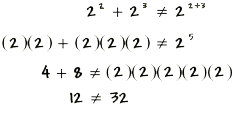
 |
| Home | Teacher | Parents | Glossary | About Us | |||||||||||
|
|
|||||||||||
|
|
Here are some simple rules to use with exponents.
ALERT! These are mistakes that students often make when dealing with exponents.
Mistake! Do not multiply the base and the exponent. 26 is not equal to 12, it's 64!
Mistake! The multiplication rule only applies to expressions with the same base. Four squared times two cubed is not the same as 8 raised to the power two plus three.

Mistake! The multiplication rule applies just to the product, not to the sum of two numbers.

Scientific
Notation
What happens when you're using a calculator and your answer is too long to
fit in the window? Use a calculator to multiply these 2 numbers:
60,000,000,000,000
x 20,000,000,000
You'll discover a short way of writing very long numbers. This is called scientific
notation, or E notation on a calculator ("E" stands for "Exponent").
A number written in scientific notation is written as a product of a number
between 1 and 10 and a power of 10.
For example, to write 127,680,000 in scientific notation, change the number to a number between 1 and 10 by moving the decimal point 8 places to the left. Then multiply by 10 raised to the power of the number of places you had to move the decimal point--that is, 108:
127,680,000
= 1.2768 x 108
On your calculator window, the base of 10 is not shown; the E means "10
raised to the following power."
Examples
7 x 7 x 7 x 7 = ? 74
2 x 2 x 2 x 2 x 2 x 2 = ? 26
110 = 1
53 = 5 x 5 x 5 = 125
Write the following
numbers in scientific notation.
565,000
= 5.65 x 105
7,325,000 = 7.325 x 106
91,247,000,000 = 9.1247 x 1010
| Homework Help | Pre-Algebra | Numbers | |||